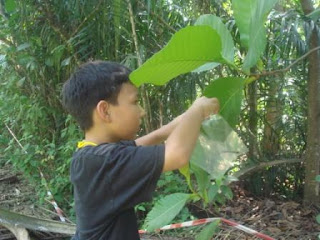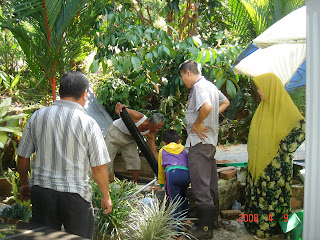 Running free: Parkour is about running from one point to another in the most effective way possible, and is usually involves vaulting, jumping or climbing over obstacles like Amir Hamzah (right) is shown doing
Running free: Parkour is about running from one point to another in the most effective way possible, and is usually involves vaulting, jumping or climbing over obstacles like Amir Hamzah (right) is shown doing Jumping around: Traceurs often make huge jumps like this in order to close gaps more efficiently
Jumping around: Traceurs often make huge jumps like this in order to close gaps more efficientlyPushing the limit
By IAN YEE
Our youths are scaling new heights with parkour, the discipline of overcoming obstacles using the mind and human body.
IMAGINE living in a bustling, congested city with tall buildings and constricting concrete everywhere you turn.
Then imagine rising above all that; having the ability to scale any sort of urban landscape, to overcome any obstacle the city throws at you, and to feel the liberation of breaking free from the claustrophobic spaces everyone else is restricted to.
It’s a liberation almost all of us crave. Hence our fascination with superheroes like Spider-Man; and the phenomenal spread of parkour.
A traceur is someone who practises parkour, a relatively new discipline that uses the human body to get from point A to point B in the most efficient manner possible.
Traceurs are able to move effortlessly from rooftop to rooftop, make death-defying jumps with perfect landings, scale seemingly impossible gaps and obstacles like walls, fences, and boulders – all with the raw athletic abilities of the human body.
They turn urban environments into huge obstacle courses for themselves to challenge the limits of their bodies, and the only catch is that the course has no safety measures.
In parkour, sheer concrete walls, multi-storeyed buildings, huge gaps and terrifying drops are just part of the racecourse.
For traceurs to overcome these obstacles, they have to become the ultimate human physical specimens – gymnasts, cross-country runners, rock-climbers, long-jumpers, and stuntmen, all in one.
Still, local traceurs Amir Hamzah, Mohd Qayyim Hafidzi and Muhammad Sabree, are willing to dedicate their time and energy to train for parkour. The trio have been practising parkour for between three and four years now, making them veterans in the local scene. Amir and Qayyim’s usual training ground is at a small park next to the Putra Mosque in Putrajaya. Sabree, who has his own parkour group in his hometown in Kuching, Sarawak, recently joined them.
At their weekly sessions, called jams, about 10 to 15 teenagers would turn up. They range from aspiring traceurs to semi-professionals like Amir, who has done stunt work for TV commercials and ambassadorial work for a Reebok roadshow.
Qayyim started getting involved in parkour after being inspired by YouTube videos of famous traceurs such as founder David Belle. And after meeting Amir on the Parkour Malaysia forum (www.pkmy.tk), the two started organising weekly jams where they train young traceurs.
The skills they produce during these jams often attract amazed onlookers. While most of the younger ones practise short jumps and perfect their landings, Amir, Qayyim and Sabree attempt jaw-dropping jumps from two to three metres high at will. They scale walls that are about two metres high, and vault over large objects 1.5m wide; all with incredible ease and fluidity.
The immense physical ability they have acquired through their training has also enabled them to do some pretty cool flips and tricks, which unsurprisingly is what the media has often highlighted about parkour.
But Qayyim believes that their physical actions are less important, as they are simply the outward expression of parkour’s core principles.
“Parkour is more than the running and physical aspect people usually see. It’s a mindset, one about challenging yourself to progress in life, and to know yourself better, especially your limitations. It has a lot to do with becoming a better person.
“I believe parkour is not just about training the muscles to help you clear a gap. It’s also about developing a good attitude and mentality to use your strength to help others,” said the 21-year-old student.
International Medical University student Sabree, 22, added: “There’s no point jumping down a 10m wall, apart from being able to say you can do it. But it’s a totally different matter if you have a loved one down there who’s in trouble. Then it would mean something.”
This same philosophy of altruism, strength and self-discovery was inherent throughout the history of parkour.
David Belle’s father, Raymond, received the French méthode naturelle (a physical and mental training method based on natural possibilities) while in the military. Its emphasis on using athletic skills for good moulded Raymond’s character.
He would become a legend, being one of the fittest and most courageous rescuers in the French elite fire fighting regiment.
Raymond's combination of physical prowess and human spirit inspired new fire fighters such as David and his colleague Sébastien Foucan.
Together they formed a group called Yamakasi with other youngsters who shared their passion for what was known then as l'art du déplacement (the art of movement).
But after a disagreement tore the group apart, David stuck to his purist approach of the art, combining positive values with the method of moving from one point to another in the most efficient manner possible, but calling it parkour.
According to Qayyim, parkour should not include some of the fancy tricks and flips that traceurs sometimes do in these days.
“Parkour is supposed to be about efficiency and going faster. If you do fancy tricks along the way, or hurt yourself in the process, that’s not efficient anymore,” he said.
Sabree agreed, adding, “If you’re in an emergency and trying to save someone, or trying to run away from some gangsters, you won’t be doing a back-flip all of a sudden, right?”
But for Amir, it’s the misconception that injuries are part and parcel of parkour that worries him sometimes.
“You’re supposed to push yourself slowly to get better, keeping your limitations in mind. You should try to take it step-by-step and train yourself to go further each time. If you’re getting hurt all the time, that means you’re getting ahead of yourself,” said Amir, 23.
In Britain, 14-year-old Alex Leatherbarrow slipped and plunged to his death while attempting to clear a 1.8m gap from the rooftop of a house, and Sabree is quick to preach caution against ill-advised parkour stunts.
“Parkour is only as dangerous as the people who perform it. You can’t perform big, dangerous jumps if you’re not ready for it, and even I still don’t do big jumps. You just have to be careful, and keep working on your basics like your rolls (a manoeuvre performed upon landing to dissipate momentum),” added Sabree.
That’s why most traceurs train every single day. Most of them perform callisthenics, as such exercises help to improve the body’s ability to withstand the rigours of parkour without bulking up the body, which reduces fluidity of movement.
Amir has a strict training regime.
“I do mostly conditioning workouts which utilise bodyweight, like push-ups, sit-ups and chin-ups for around two hours a day, and I go for jams on weekends.”
But apart from the physical benefits, the philosophy of parkour brings about better lifestyle habits too. For instance, traceurs usually don’t smoke or drink, because that would affect their body's endurance and agility.
Most traceurs say they get an increased awareness of their surroundings, are more focused, and tend to view problems and obstacles more positively. And these varied benefits are something that Qayyim sees in his own personal experience of the discipline.
“That’s what I love most about parkour – it gives you strength, not just physically, but mentally and spiritually, too. We’re obviously physically fit, but you also have to be mentally strong to challenge yourself the way we do with parkour. And in terms of spirituality, we’re always mindful that the essence of parkour is to do good, that we’re pushing ourselves to become better individuals.”
For more images of the traceurs in action, log on to www.rage.com.my.















































